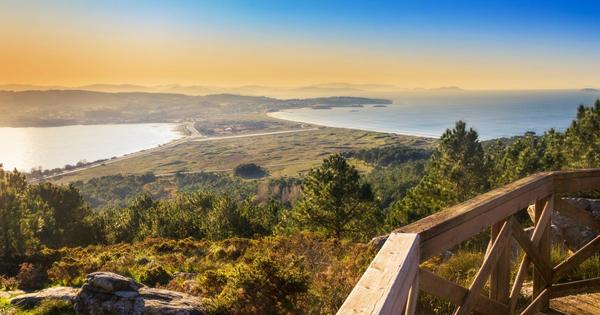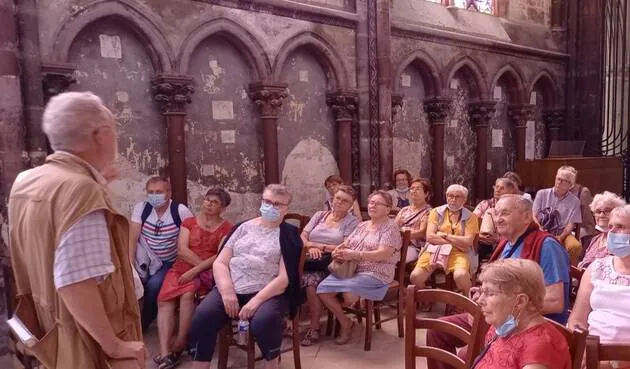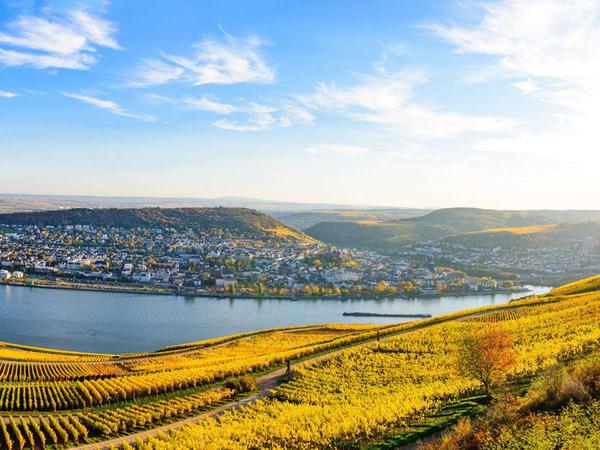12 magical corners to visit in O Salnés
Landscapes that are recorded in the retina, a much warmer climate and a spectacular gastronomy have made the region of Salnés one of the most tourist and privileged areas of the Baixas Rías.To facilitate your visit, we have prepared a small list with some of the corners you must visit if you end up in any of its nine municipalities.Discovering the rest is in your hands.
Pazo-Convento de Vista Alegre (Vilagarcía de Arousa)
One of the mandatory stops on this tour is in the center of Vilagarcía de Aruous, we talk about the Pazo-Convento de Vista Alegre.It is one of the stately houses with more history, and the only one with distinction of artistic historical monument in the town.Its entrance represents an authentic postcard stamp, crossing the bridge over the river with the Vista Alegre arc, which gives access to the set formed by the pazo and the church.In its granite facade you can still clearly see the great shields of Archbishopales weapons and symbols that dress the entire structure.
You have to go back to the mid -fifteenth century to know the ins and outs of this unique construction, which sinks its roots in the foundation of Vilagarcía itself, when García Caamaño ordered to build a tower in the place.The fire would end up devouring the structure and on its ashes the current Pazo would later rise.Already entered the seventeenth century, the convent of the Agustinas Recoletas nuns would be founded, which would end up united to the Pazo through a characteristic arc-passing, used by the lords of the hamlet to go to the masses without mixing with the people.
Monte Xiabre (Vilagarcía de Arousa)
Mount Xiabre is a mountainous system distributed among the towns of Caldas de Reis, Catoira and Vilagarcía de Aruous.This is the highest point of O Salnés, and in its peak, located in the Arousano municipality, it reaches a height of about 642 meters.There is a viewpoint from which you can see the Ría de Arousa, all the urban layout of Vilagarcía, Caldas de Reis and much of the Valle do Salnés and the Umia.
This impressive viewpoint has become a great tourist attraction, especially after the construction of a wind farTo be able to contemplate the majesty of the eight towers a few meters away.
The Mount of Xiabre also hosts several routes and numerous viewpoints.In one of them is the almost unknown Cruz de Xiabre, who resembles his neighbor of Monte Lobeira.Also the remains of a Castro on the peak of A XAIBA, some funeral mound and several petroglyphs, mostly scattered throughout the east hillside, leave the inhabited past of this mountain and provide great cultural value.And another of the most visited areas is the prairie of "Fontefría", with several snacks, surrounded by streams and nature that make it a perfect place to spend the day.
Faro Mirador das Lúas and Monte Lobeira (Vilanova de Aruous)
In neighboring Vilanova de Aruous there are two of the best viewpoints of all or Salnés, with some comprehensive panoramic views of the Arousa estuary, the Peninsula do Barbanza and a good part of the region.The first one is the Mirador Faro das Lúas, named for the original structure that stands in the place, created by the Vilagarcian artist Manolo Chazo.The tower represents three moons in a waning room, which project a reflection that can be seen from different points of the region according to the opposition that the sun occupies during the day.

A few kilometers is located the Mirador de Monte Lobeira, a mountain range that reaches 290 meters high.His top, in addition to having spectacular views, treasures great stories and legends: from castros, to castles and underground tunnels.Already in 1869 a large metal cross was lifted at the summit in memory of the victims and missing from the sinking of the British ship-school "Serpent".
Punta Cabalo lighthouse (illa from Arousa)
The lighthouse of Punta Cabalo, located in the most northwest area of the Illa de Arousa, is a small paradise where to disconnect and enjoy the unique landscape offered by the Ría de Arousa.It can be easily arrived through a enabled path that ends on a wooden walk.To the left of the place is the beach of Sualaxe and under the waters that surround the lighthouse, a colony of seahorses is hidden.
The lighthouse was built in 1852 on a very peculiar rocky enclave.In Galicia, the rocks that carved by the wind and the sea get a very unique appearance are called "perm."These rocks are prolonged throughout the coast and even configure the main attraction of one of the best known routes in A Illa, the "Route two Cons".At present, the lighthouse of Punta Cabalo houses a cozy restaurant with a lot of sea flavor and privileged views.
Areoso islet
One of the most precious natural treasures of the Arousa Illa is formed by one of its islet paradisiacal: that of Areoso Xiairo, better known as "Ibillote do Areoso."To visit it there are different routes in kayak, boat or sailboat.It is a natural and protected space in the surroundings of the Punta Carreirón Natural Park, with just about 600 meters from north to south.O areoso is surrounded by crystalline waters, a reef and formed almost entirely by fine sand.In fact, it looks like a small area of vegetation, and in the environment, despite its small size, archaeological remains, such as a dolmen and several megalithic mounds.However, it is not surprising that in recent years the islet has catapulted fame, putting its state of conservation at risk.
Ruins of Santa Mariña de Dozo (Cambados)
Cambados stands out for being a great outdoor museum, for its historical character and, without a doubt, also for its Albariño.At the foot of the mountain of A Pastora, where the viewpoint and a chapel are located, there is one of the most unique jewels of the municipality, the ruins of Santa Mariña de Dozo.The remains of the ancient parish church of Santa Mariña, patron saint of changedCunqueiro
Today, only four transverse arches, five side chapels, the sacristy and the main chapel are preserved.The ruins were declared a National Monument in 1943, chosen in 2014 as the third most important funeral monument in Spain and included the same year in the Association of Significant Cemeteries of Europe.
Castro De Leiro or Besomaña (Ribadumia)
In Ribadumia, between the parishes of Leiro and Besomaño, we find the archaeological site of Monte do Castro.Since 2010, numerous excavations and reconstructions of homes have been carried out that leave the great historical and archaeological value of the place.After these interventions, an occupation and re -ocupation period that goes from the fourth century BC was set.Until the 1st century A.D.In addition, more than 21,000 pieces have been documented, including ceramics, mills, bronzes and other elements;And in the environment the traces of ancient quarries are also preserved.Without a doubt, approaching the Castro de Leiro and Besomaño is the perfect way to disconnect and perform an outdoor cultural plan, walking between centuries of history and with a good panoramic view of the Valley of Salnés.
MONASTERIO DE ARMEIRA (MEIS)
Any traveler who arrives in Meis cannot leave without first visiting the famous monastery of Santa María da Armenteira: dated from the 12th century, of Romanesque style and whose origins are wrapped in the legend.In this ancient Cistercian monastery, the massive pilgrimage of the Virgen de las Cabezas is celebrated every year, to which healing capabilities are attributed in terms of pains and heads.same order, that offer a monastic lodge service through their own website.
The interior of the monastery can be visited for free and prior reserve through the tourism office found in the place.And for those who cannot wait for perimeter closures to be lifted, the Galician tourism page offers the option to navigate its interior in a hyperrealistic way.In addition, the monastery is also the starting point of the well -known Route Da Pedra e A Auga, a path of 8 kilometers that runs between mills, pools and small waterfalls.
Telleira de Seixiños (meaño)
For those who enjoy the paths with charm and history, for the parish of Dena, in the City of Meaño, part of the Das Telleiras route takes place.From O Grove to Dena, up to 28 tile and brick factories that began their work in the early nineteenth century.In this area, next to the mouth of the Chanco River, the existence of clay and caolin deposits served as raw material for these factories.
Currently, none of these Telleiras is active, although some have been rehabilitated, such as the Telleira de Seixiños that still retains its original oven, the chimney and part of the jetty.It is integrated into the Umia-or Grove intention, and in front of it, on the other side of the wetland, the current interpretation center of Sanxenxo is located.
San Vicente do Mar (or Grove)
Or Grove can boast between its limits more than a unique tourist attraction in the world, such as its chapel of the shells or the village of the Grobits in A toxa.But there is something that the Meco municipality stands out is for its infinite beaches and paths on the foot of coast.
The Pedras Negras route is one of the most beautiful and unique.Tour the entire wooden seap of San Vicente do Mar to the area with black.The Paseo borders the entire coast, which stands out for its numerous rocky surfaces and the coves of turquoise waters that are arranged every little time.In the middle of this path a small viewpoint is located with a monument to the Volunteers of the Prestige, and a few meters the so famous nautical of San Vicente.
Ermita da launched (Sanxenxo)
One of the compulsory stops of the Tourist Municipality of Sanxenxo passes through the hermitage of Our Lady of La Lanzada, delimited to its left by the beach of Foxos and to its right by those of Gorda Area, Lapa, and the more than well -known beach of A launched.A place full of history, legends and unbeatable views of the ocean and the island of Ons.
The hermitage is launched is Romanesque and dates from the beginning of the 12th century.It is formed by a single semicircular ship and apse at different heights.In the area, the remains of a fortress already in ruins are also preserved that dates back to the 10th century, part of the Torre da launched and the excavation of an ancient military necropolis.Also, in front of the entrance door to the hermitage are staircases that descend to the front that gives to the sea.
Faxilda Punta (Sanxenxo)
The coast of the municipality of Sanxenxo is full, mostly, by white sand beaches.The Cabo de Punta Faxilda, in the parish of Noalla, is presented as one of the few exceptions, surrounded by cliffs that complete one of the most privileged panoramic views of the Atlantic Ocean.
Like many other points of the Galician geography, or Salnés has also lived its own rise of placement of banks with the most beautiful and exclusive views.In Punta Faxilda one of Notela's well -known banks was installed, in a unique place from which to observe the best sunsets with the Cíes, Ons and Sálvora islands as a backdrop.A few steps from the Bank of Noalla is a stone sculpture and the "Porta do Sol", a wooden frame that serves as a perfect frame for the falls of the star.


